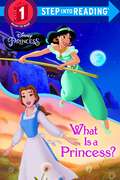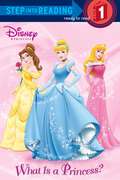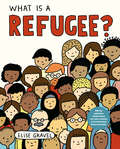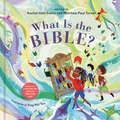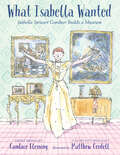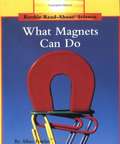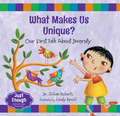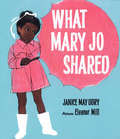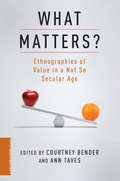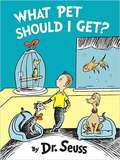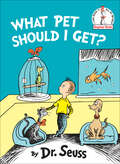- Table View
- List View
What Is a Family? (The\changing Face Of Modern Families Ser.)
by Annette GriffinAnts have a colony.Bats have a cloud.Chickens have peeps,where they can get loud.All the way from A to Z, this colorful alphabet primer celebrates all kinds of diverse families, giving each animal family a name. With dolphins and their pods, iguanas and their messes, and kitties and their litters, it&’s easy to learn about what makes a family . . . well, a family! Packaged as a well-crafted, sturdy, padded board book, it will stand up to years of exploration. Whether you are teaching the alphabet, animals, different types of families, or celebrating your own unique family, What is a Family is a colorful and fun introduction to the families all around us. Families are groups that take care of their own.They all stick together to help make a home.
What Is a Princess? (Step into Reading)
by Jennifer LibertsThe Disney princesses are adventurous, kind, and ready for anything! This Step 1 Deluxe Step into Reading leveled reader is perfect for children ages 4 to 6. The book features Snow White, Belle, Jasmine, Ariel, Sleeping Beauty, and Cinderella!
What Is a Princess? (Step into Reading)
by Jennifer Liberts Weinberg RH DisneyWHAT IS A princess? Is she someone who is smart and brave, kind and caring—or is she someone much, much more? Cinderella, Ariel, Belle, and all the Disney Princesses answer that question in this Step 1 book that is the first in the Step into Readling line to feature multiple Disney Princesses in one book!
What Is a Pronoun? (Parts Of Speech Ser.)
by Sheri DoyleWhat is a pronoun? Is it HER? Is it THEM? Maybe ME? Take a peek inside to see if it's YOU!
What Is a Refugee?
by Elise GravelAn accessible picture book that oh-so-simply and graphically introduces the term "refugee" to curious young children to help them better understand the world in which they live.Who are refugees? Why are they called that word? Why do they need to leave their country? Why are they sometimes not welcome in their new country? In this relevant picture book for the youngest children, author-illustrator Elise Gravel explores what it means to be a refugee in bold, graphic illustrations and spare text. This is the perfect tool to introduce an important and timely topic to children.
What Is the Bible?
by Rachel Held Evans Matthew Paul TurnerIn this vibrant picture book adventure, the authors of the #1 New York Times bestseller What Is God Like? invite children to learn about the Bible—what it tells us about God and what God says about us!Children have been wondering about the Bible for centuries. What do all these long-ago stories have to do with each other—and with me? This whimsical and lyrical book, inspired by the work and ideas of the late Rachel Held Evans and completed by her good friend Matthew Paul Turner, explains that the Bible is a big library of amazing stories about God, the world, and Jesus. When you read those stories, you will understand the world differently—and you can make the world different too. What Is the Bible? is a spectacular journey, guiding children to see how God's story and our own lives are delightfully intertwined. Kids and parents alike will see that God's story is big enough to be found all over the world and close enough to find in our own hearts.
What Is the World Made Of?: All About Solids, Liquids, and Gases (Let's-Read-and-Find-Out Science 2)
by Kathleen Weidner ZoehfeldRead and find out about the three states of matter—solid, liquid, and gas—in this colorfully illustrated nonfiction picture book.Can you make an ice cube disappear? Put it on a hot sidewalk. It melts into water and then vanishes! The ice cube changes from solid to liquid to gas. This Level 2 Let's-Read-and-Find-Out picture book is a fascinating exploration of the three states of matter.This clear and appealing science book for early elementary age kids, both at home and in the classroom, uses simple, fun diagrams to explain the difference between solids, liquids, and gases. This book also includes a find out more section with experiments designed to encourage further exploration and introduce record keeping.This is a Level 2 Let's-Read-and-Find-Out, which means the book explores more challenging concepts for children in the primary grades. The 100+ titles in this leading nonfiction series are:hands-on and visualacclaimed and trustedgreat for classroomsTop 10 reasons to love LRFOs:Entertain and educate at the same timeHave appealing, child-centered topicsDevelopmentally appropriate for emerging readersFocused; answering questions instead of using survey approachEmploy engaging picture book quality illustrationsUse simple charts and graphics to improve visual literacy skillsFeature hands-on activities to engage young scientistsMeet national science education standardsWritten/illustrated by award-winning authors/illustrators & vetted by an expert in the fieldOver 130 titles in print, meeting a wide range of kids' scientific interestsBooks in this series support the Common Core Learning Standards, Next Generation Science Standards, and the Science, Technology, Engineering, and Math (STEM) standards. Let's-Read-and-Find-Out is the winner of the American Association for the Advancement of Science/Subaru Science Books & Films Prize for Outstanding Science Series.
What Isabella Wanted: Isabella Stewart Gardner Builds a Museum
by Candace FlemingFrom multiple award-winning author Candace Fleming and Caldecott Medalist Matthew Cordell comes the true story of a woman who always got what she wanted: Isabella Stewart Gardner.A New England Book Award FinalistFor years, the indomitable Isabella Stewart Gardner searched the world for magnificent artwork and filled her home with a truly unique collection, with the aim of turning it into a museum, which she established in 1903.Isabella always did things her own way. One day she'd wear baseball gear to the symphony, the next, she'd be seen strolling down the street with zoo lions. It was no surprised that she was very particular about how she arranged her exhibits. They were not organized historically, stylistically, or by artist. Instead, they were arranged based on the connections Isabella felt toward the art, a connection she hoped to encourage in her visitors.For years, her museum delighted generations of Bostonians and visitors with the collections arranged exactly as she wanted. But in 1990, a spectacular burglary occurred when two thieves disguised as police officers stole thirteen paintings, valued at $500 million, including a Rembrandt and a Vermeer. They have yet to be recovered, though a $10 million reward is still being offered for their safe return.Author Candace Fleming perfectly captures Isabella's inimitable personality and drive, accompanied by exuberant illustrations by Matthew Cordell.A Junior Library Guild Gold Standard SelectionA CCBC Choice
What Kind of Car Does a T. Rex Drive?
by Mark LeeDinosaurs find their ideal vehicles in this hilarious, crowd-pleasing read-aloud, perfect for fans of Dragons Love Tacos and Goodnight, Goodnight, Construction Site. It's the perfect gift for dinosaur lovers and fans of cars, trucks, and all things that go!When a stegosaurus, a pterodactyl, and a triceratops all show up at Uncle Otto's car lot, he doesn't have a clue how to help them. After all, he's never sold a car to a dinosaur before. Luckily, Ava and Mickey--two kids with a lot of dino knowledge--are there to help pair each customer with the perfect vehicle. But here comes the T. Rex, and he wants to buy a car too! And he's surprisingly hard to please... So what kind of car does a T. Rex drive? A microcar? A convertible? A minivan? You'll just have to read to find out!"A delightful blend of dinosaurs with things that go, sure to entertain aficionados of both." --Booklist"Only the extinct would fail to enjoy this kicky amalgamation of dinos, deals, and automobiles." --Kirkus Reviews"Smashed cars, expert kids, dinosaurs! Customer satisfaction guaranteed!" --The Horn Book Magazine
What Kind of Shoes Does a Hippopotamus Choose?
by Kat MaconieFrom award-winning shoe designer Kat Maconie comes a rollicking rhyming tale about many critters and the numerous shoes they wear."Entertaining, silly, and stylish fun."--Kirkus ReviewsEveryone knows that gators love waders for splishing and splashing around.While up on the docks you'll find spiky-toothed crocsin stilettos for going to town.But what kind of shoes does a hippopotamus choose?This gorgeously witty picture book will delight and entertain readers of all ages. Readers will love calling out the cats in smart ballet flats, the bears wearing boat shoes, donkeys in mules embellished with jewels, and many, many more. With stunning illustrations by Sebastien Braun, What Kind of Shoes Does a Hippopotamus Wear? will be a book destined to be picked up and read over and over again.
What Lives in a Shell? (Let's-Read-and-Find-Out Science 1)
by Kathleen Weidner ZoehfeldRead and find out about what lives in a shell in this colorfully illustrated nonfiction picture book.A house is a home for you, a nest is a home for a bird, and a cave is a home for a bear. But for some animals a shell is a home. Snails and turtles and crabs and clams all have shells that act as their homes and protect them from harm.This clear and appealing book for early elementary age kids, both at home and in the classroom, is a fascinating exploration of the many creatures that make a home in a shell. This picture book features beautifully accurate illustrations of the many types of shells—inside and out! Young readers will love exploring the fascinating homes of creatures like hermit crabs, scallops, and turtles.This is a Level 1 Let's-Read-and-Find-Out, which means the book explores introductory concepts perfect for children in the primary grades. The 100+ titles in this leading nonfiction series are:hands-on and visualacclaimed and trustedgreat for classroomsTop 10 reasons to love LRFOs:Entertain and educate at the same timeHave appealing, child-centered topicsDevelopmentally appropriate for emerging readersFocused; answering questions instead of using survey approachEmploy engaging picture book quality illustrationsUse simple charts and graphics to improve visual literacy skillsFeature hands-on activities to engage young scientistsMeet national science education standardsWritten/illustrated by award-winning authors/illustrators & vetted by an expert in the fieldOver 130 titles in print, meeting a wide range of kids' scientific interestsBooks in this series support the Common Core Learning Standards, Next Generation Science Standards, and the Science, Technology, Engineering, and Math (STEM) standards. Let's-Read-and-Find-Out is the winner of the American Association for the Advancement of Science/Subaru Science Books & Films Prize for Outstanding Science Series.
What Magnets Can Do
by Allan FowlerDesigned to provide children with "hands-on" experience in magnetism and magnets.
What Makes Day and Night
by Franklyn M. Branley"What Makes Day and Night" goes through the cycle of the earth and its revolutions around the sun.
What Makes Different Sounds (I Wonder Why Ser.)
by Lawrence LoweryOn their walk home from school, twins Jane and Jim explore why sounds can be startling (like sirens), soothing (like music), or mysterious (like eerie creaking in an empty house). By coming along, young readers of What Makes Different Sounds? can learn as the twins do. They’ll be introduced to the roles vibration, pitch, and volume play in how rustles, rumbles, and rat-a-tat-tats are made and transferred to their own ears. What Makes Different Sounds? is part of the I Wonder Why book series, written to ignite the curiosity of children in grades K–6 while encouraging them to become avid readers. These books explore the marvels of sound, animals, plants, and other phenomena related to science and nature. Included in each edition is a Parent/Teacher Handbook with coordinating activities. The I Wonder Why series is written by an award-winning science educator and published by NSTA Kids, a division of NSTA Press.
What Makes Me Special: A neurodiverse child's journey
by Claudia Rose AddeoThis children’s piece of literature can be read by children ages 4-9, but also welcomes readers of all ages who are among the neurodiverse community. This bright, colorful children’s book reflects the author’s childhood navigating a mainstream education system through the eyes of a neurodiverse learner. A very happy-go-lucky child shares all of the obstacles and gifts that come with being a neurodiverse learner and how that can appear in her everyday life. Whether it entails navigating sensory overload, demonstrating her creative talents, or receiving special education services, Claudia shares all of the unique aspects of her childhood that also relate to so many other children among the neurodiverse community. Though there are certainly times that Claudia can face challenges that appear overwhelming, this sensitive, kind, and optimistic little girl always manages to remind herself that hard work does pay off and understands that these are the qualities that make her special. Claudia reminds readers of all ages the importance of being kind and accepting of one another, as well as being able to recognize the many beautiful gifts neurodiverse learners possess that make them special!
What Makes Us Unique?: Our First Talk About Diversity (Just Enough)
by Cindy Revell Dr Jillian RobertsWhen it comes to explaining physical, cultural and religious differences to children, it can be difficult to know where to begin. What Makes Us Unique? provides an accessible introduction to the concept of diversity, teaching children how to respect and celebrate people's differences and that ultimately, we are all much more alike than we are different. Additional questions at the back of the book allow for further discussion. Child psychologist Dr. Jillian Roberts designed the Just Enough series to empower parents/caregivers to start conversations with young ones about difficult or challenging subject matter. Other books in the series deal with birth, death, separation and divorce. For more information, visit www.justenoughseries.com.
What Makes a Blizzard? (Let's-Read-and-Find-Out Science 2)
by Kathleen Weidner ZoehfeldRead and find out about blizzards in this colorfully illustrated nonfiction picture book.All blizzards are snowstorms, but not all snowstorms are blizzards. What is the difference? How much snow falls during a blizzard? How fast are the winds? How cold does it get during a blizzard? Read and find out! What Makes a Blizzard comes chock-full of visual aids like charts, sidebars, and hands-on activities—including how to keep a winter weather journal and how to observe what a snowflake really looks like.This is a clear and appealing science book for early elementary age kids, both at home and in the classroom. It's a Level 2 Let's-Read-and-Find-Out, which means the book explores more challenging concepts for children in the primary grades. The 100+ titles in this leading nonfiction series are:hands-on and visualacclaimed and trustedgreat for classroomsTop 10 reasons to love LRFOs:Entertain and educate at the same timeHave appealing, child-centered topicsDevelopmentally appropriate for emerging readersFocused; answering questions instead of using survey approachEmploy engaging picture book quality illustrationsUse simple charts and graphics to improve visual literacy skillsFeature hands-on activities to engage young scientistsMeet national science education standardsWritten/illustrated by award-winning authors/illustrators & vetted by an expert in the fieldOver 130 titles in print, meeting a wide range of kids' scientific interestsBooks in this series support the Common Core Learning Standards, Next Generation Science Standards, and the Science, Technology, Engineering, and Math (STEM) standards. Let's-Read-and-Find-Out is the winner of the American Association for the Advancement of Science/Subaru Science Books & Films Prize for Outstanding Science Series.
What Makes a Magnet?
by Franklyn M. BranleyDescribes how magnets work and includes instructions for making a magnet and a compass. A book in the Let's-Read-and-Find-Out Science book series.
What Makes a Magnet? (Let's-Read-and-Find-Out Science 2 #Stage 2)
by Dr. Franklyn M. BranleyRead and find out about magnets in this colorfully illustrated nonfiction picture book.Why does a magnet pick up a paper clip but not a leaf or a penny? How can the whole world be a magnet?Follow the step-by-step instructions about how to make your own magnet, and then find out for yourself what makes a magnet!This is a clear and appealing science book for early elementary age kids, both at home and in the classroom. It's a Level 2 Let's-Read-and-Find-Out, which means the book explores more challenging concepts for children in the primary grades. The 100+ titles in this leading nonfiction series are:hands-on and visualacclaimed and trustedgreat for classroomsTop 10 reasons to love LRFOs:Entertain and educate at the same timeHave appealing, child-centered topicsDevelopmentally appropriate for emerging readersFocused; answering questions instead of using survey approachEmploy engaging picture book quality illustrationsUse simple charts and graphics to improve visual literacy skillsFeature hands-on activities to engage young scientistsMeet national science education standardsWritten/illustrated by award-winning authors/illustrators & vetted by an expert in the fieldOver 130 titles in print, meeting a wide range of kids' scientific interestsBooks in this series support the Common Core Learning Standards, Next Generation Science Standards, and the Science, Technology, Engineering, and Math (STEM) standards. Let's-Read-and-Find-Out is the winner of the American Association for the Advancement of Science/Subaru Science Books & Films Prize for Outstanding Science Series.
What Mary Jo Shared
by Janice May Udry Elizabeth SaylesMary Jo is a very shy little girl. When it comes time to share something in class she has nothing to share. She comes up with several ideas of what to share, but at the last minute says she has nothing to share. In the end she is able to find the perfect thing to share. It is something that no one else in the class has thought of sharing before.
What Matters?: Ethnographies of Value in a Not So Secular Age (A Columbia / SSRC Book)
by Ann Taves Courtney BenderOver the past decade, religious, secular, and spiritual distinctions have broken down, forcing scholars to rethink secularity and its relationship to society. Since classifying a person, activity, or experience as religious or otherwise is an important act of valuation, one that defines the characteristics of a group and its relation to others, scholars are struggling to recast these concepts in our increasingly ambiguous, pluralistic world.This collection considers religious and secular categories and what they mean to those who seek valuable, ethical lives. As they investigate how individuals and groups determine significance, set goals, and attribute meaning, contributors illustrate the ways in which religious, secular, and spiritual designations serve as markers of value. Reflecting on recent ethnographic and historical research, chapters explore contemporary psychical research and liberal American homeschooling; the work of nineteenth and early-twentieth-century American psychologists and French archaeologists; the role of contemporary humanitarian and volunteer organizations based in Europe and India; and the prevalence of highly mediated and spiritualized publics, from international psy-trance festivals to Ghanaian national political contexts. Contributors particularly focus on the role of ambivalence, attachment, and disaffection in the formation of religious, secular, and spiritual identities, resetting research on secular society and contemporary religious life while illuminating what matters in the lives of ordinary individuals.
What Mess?
by Tom LichtenheldPreviously published in hardcover with the title "What's With This Room?" Why is this room such a mess all the time? What's with that smell, and what's with the grime? What Mess?is a hilarious conversation between a boy and his parents about a room that's such a disaster zone, he'd have to clean it just to call it a mess.
What Pet Should I Get?
by Dr SeussThis never-ever-before-seen picture book by Dr. Seuss about making up one's mind is the literary equivalent of buried treasure! What happens when a brother and sister visit a pet store to pick a pet? Naturally, they can't choose just one! <P><P> The tale captures a classic childhood moment--choosing a pet--and uses it to illuminate a life lesson: that it is hard to make up your mind, but sometimes you just have to do it! <P> Told in Dr. Seuss's signature rhyming style, this is a must-have for Seuss fans and book collectors, and a perfect choice for the holidays, birthdays, and happy occasions of all kinds. <P> An Editor's Note at the end discusses Dr. Seuss's pets, his creative process, and the discovery of the manuscript and illustrations for What Pet Should I Get?
What Pet Should I Get? (Beginner Books)
by Dr. SeussPick a pet with Dr. Seuss with this bestselling and silly tail of cats, dogs and more! A dog or a cat? A fish or a bird? Or maybe a crazy creature straight from the mind of Dr. Seuss! Which pet would YOU get? A trip to the pet store turns into a hilarious struggle when two kids must choose one pet to take home... but everytime they think they see an animal they like, they find something even better! Perfect for animal lovers and Seuss lover alike, this book will delight readers young and old. Discovered 22 years after Dr. Seuss's death, the unpublished manuscript and sketches for What Pet Should I Get? were previously published as a 48-page jacketed hardcover with 8 pages of commentary. This unjacketed Beginner Book edition features the story only. The cat? Or the dog? The kitten? The pup? Oh, boy! It is something to make a mind up. Beginner Books are fun, funny, and easy to read! Launched by Dr. Seuss in 1957 with the publication of The Cat in the Hat, this beloved early reader series motivates children to read on their own by using simple words with illustrations that give clues to their meaning. Featuring a combination of kid appeal, supportive vocabulary, and bright, cheerful art, Beginner Books will encourage a love of reading in children ages 3–7.

